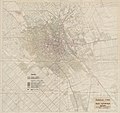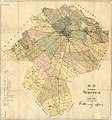GLAM/Newsletter/October 2017/Contents/Serbia report
|
Wikipedian in residence at Historical Archives of Subotica; Model of a grain of wheat exlusivly digitized for Wikimedia Commons; Cooperation of the Ministry of Culture and Information and Wikimedia Serbia - GLAM presentations and workshops for museums, archives and libraries
Wikipedian in residence at Historical Archives of Subotica
Historical archives of Subotica became a part of Wikimedia’s global GLAM program this past August by taking in Vladimir Nimčević, our choice for Wikipedian in residence for 2017 in Serbia. Vladimir, a dedicated Wikipedian and a master historian, researched, analyzed, and digitized rare documents that were considered lost for a long time, and he digitized five books, 12 maps of Subotica over the centuries, and 160 other rare documents, in addition to writing 18 new articles on Serbian Wikipedia, Wikimedia Commons, and Serbian Wikisource.
A significant amount of focus was placed upon the Fund 179 and the oldest documents, from the end of the first half of the 18th century, for which it was believed for a long time that they were lost in an irreversible manner. However, most of the documents were found in place and in good condition. A part of that collection was digitized and uploaded on Wikimedia Commons with two goals: to make it public and to encourage academic circles to research 18th century history of Subotica.
During the residence, 12 maps from 1697 - 1950 have been digitized, along with photos and records of noble historians and residents of Subotica.
Among five books, the first translation on Serbian of Daniel Defoe's Robinson Crusoe was digitized as well.
Part of the residence program was a presentation for employees in the archives about working with Wikipedia and other wiki projects. During the residence program, Vladimir received help from other Wikipedians who are working in the archives.

Mr. Stevan Mačković, general manager of Historical Archives of Subotica, said that the rare documents from Fund 179 which Vladimir researched and found will now be revised, which is a regular procedure for making a new overview of the archival materials.
— Every fund or a collection that is used for research is changeable, and can be damaged. Once settled and cultivated, the fund is not a closed time capsule, intangible and isolated, it’s the exact opposite - it should be opened, available, and should correspond with the potential users. That’s the story with Fund 179. We will complete the digitization of the whole fund and protect it for good. Basically, Vladimir showed us the path that the archives should follow - revision and digitization of this fund.
The manager Mačković thinks that every step that leads to a better protection of the archive collections is a basic function of every archive. — Making the collections available online is a final step in the digitization process. In a very scattered and broad virtual world, a Wikimedia concept has a specific weight. The archives themselves and our collections can contribute to that concept, in a same manner that Wikimedia users can be introduced to a huge heritage stored in the archives. The digitization of this project opened and showed us the ways we plan to follow. Our digitization plans will definitely consider the showed guidelines. Since we already have a strategic segment of an e-research, we’ll continue to expand it and enrich it. Expanding the opportunities for a broader audience to see the archive collections is one of the main tasks of every archive, and in this case it is leaning onto a Wikimedia project — Mačković concluded.
Read more on Wikimedia Serbia's blog (in Serbian).
Model of a grain of wheat exlusivly digitized for Wikimedia Commons
The Museum in Trstenik enabled an exclusive photoshoot of a clay model of a grain of wheat, stored in the Archaeological collection of the Faculty of Philosophy, University in Belgrade. The model is 8000 years old and it is believed that the oldest city map in the world is carved on its back.

The clay model of a grain of wheat was found during the archeological research of a neolithic settlement Blagotin, in the municipality of Trstenik. The size of the model is about 7cm, and unusual geometric stripes are carved on the back. The archaeologist in charge of this research, Svetozar Stanković Nani PhD, estimated that it is an urbanistic map of Blagotin, which can be considered to be the oldest urbanistic map in the world. On the other hand, a French archeologist Emilija Jovanović–Mason, estimated that the stripes on the back represent a map of the sky over Blagotin (the Moon, the Sun, and the stars), which can be considered as the oldest astronomical map of the sky in human history.
Since the model is stored at the Faculty of Philosophy and is not available to the general public, Wikimedia Serbia got a special permission to take photos of it and upload them on Wikimedia Commons under the Creative Commons licence, and thus enabled sharing knowledge about this cultural heritage of Serbia. The volunteers of Wikimedia Serbia happily took this opportunity, so Marija Gajic took the photos, and Milos Todorovic wrote an article on Serbian Wikipedia.

Jelena Vukčević, a historian and manager of Museum in Trstenik, said that digitization of this clay model of a grain of wheat and its upload on Wikimedia Commons has immeasurable value for the town of Trstenik and the Museum. — This model of a grain of wheat, found at the archaeological site Blagotin, was given to the Archaeological collection of the Faculty of Philosophy in Belgrade for storage, along with other important artifacts from this locality. Since then, for the last 20 years, the citizens of Trstenik had the opportunity to enjoy this cultural heritage only twice, through exhibitions in the town. This cooperation with Wikimedia Serbia gave visibility to this valuable archaeological museum piece, making it available to the whole world. The Wikipedia article about this model and the archeological site Blagotin will be presented to the Trstenik public through the Museum’s Facebook page, and linked on the website of National university in Trstenik. Since the museum doesn’t have space for a permanent exhibition, the digitization of the museum's collections for our institution is a very important step in the process of presenting stored cultural heritage - Jelena concludes.
The cooperation with the Museum in Trstenik will be intensively continued in next year, through a digitization process and other models of cooperation from the GLAM program.
Read more on Wikimedia Serbia's blog (in Serbian).
Cooperation of the Ministry of Culture and Information and Wikimedia Serbia: GLAM presentations and workshops for museums, archives and libraries
During the three days of workshops at Ministry of Culture and Information, Wikimedia Serbia’s team educated 60 employees from 29 institutions about the possibilities for contribution to a free content, free licences, and an importance of sharing knowledge and expanding visibility of the institution collections on the internet.

The workshops were held for the representatives of museums, archives and libraries in Serbia, registered for this training. There were more participants than expected, which is the proof that this kind of training is more than necessary.
Dejan Masliković, assistant to the Minister of Culture, greeted the gathered GLAM-ers with a hope that this will start a successful cooperation and a better presence of cultural institutions on the internet and Wikipedia.
Wikimedia Movement, Foundation, the Serbian chapter, the differences between Wikimedia and Wikipedia were all presented consecutively. The main focus of the training was put on the GLAM program, followed by the presentation of the free licences. After the presentations, an interactive workshop was held on the basics in editing Wikipedia and the upload process on Wikimedia Commons. The day was enriched for the librarians with a presentation of the Wiki Librarian project in Serbia.
Assistant to the Minister Masliković thinks that it is essential to make online content relevant and verified so that the Serbian culture can be well positioned in relation to the world culture and current world affairs, highlighting the big interest for this training.
Natalija Vukilić from the Museum of Vojvodina said that the training was very important, and added that this is the first time that the Ministry of Culture is organizing serious seminars and workshops applicable in practical work, which is very important for cultural institutions.
Slađana Bojković from Historical museum of Serbia agrees with her, and notices that digitization is a big and important step for Serbia. “This is the way to achieve it, accept it, and realize it in right way” - Bojković concludes.
Participants of all three workshops were given the certificates, and, considering the amount of attention and interest for this training, the course will be probably organized again.
Read more on Wikimedia Serbia's blog.






























